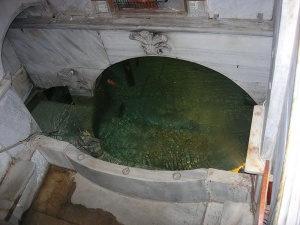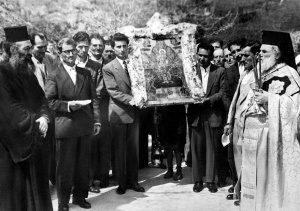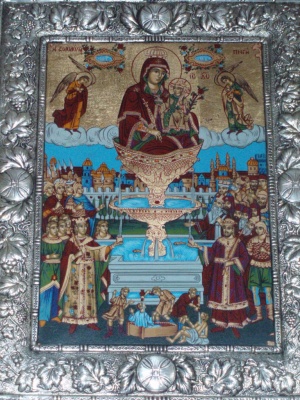Difference between revisions of "Life-Giving Spring"
(add icon) |
(→List of Churches and Monasteries) |
||
| Line 56: | Line 56: | ||
'''Churches'''<br> | '''Churches'''<br> | ||
| − | *[http://www.zoodohospigi.gr/ The Life-Giving Spring] Acadimias, Athens | + | * [http://www.zoodohospigi.gr/ The Life-Giving Spring] Acadimias, Athens |
| − | *[http://www.theotokos-lifegiving-spring.org/ Theotokos of the Life-Giving Spring Russian Orthodox Mission] - Bryan, Texas | + | * [http://www.theotokos-lifegiving-spring.org/ Theotokos of the Life-Giving Spring Russian Orthodox Mission] -- Bryan, Texas |
'''Monasteries'''<br> | '''Monasteries'''<br> | ||
| − | *Original monastery in Constantinople. | + | * Original monastery in Constantinople. |
| − | *[http://www.malf.net/spring.htm Monastery of the Theotokos the Life-Giving Spring] - Dunlap, California | + | * [http://www.malf.net/spring.htm Monastery of the Theotokos the Life-Giving Spring] -- Dunlap, California. |
| + | * Monastery of the Life-Giving Spring -- [http://hellas.teipir.gr/thesis/pellana/greek/kastrig.htm Kastri], [[w:Pellana|Pellana]] municipality, [[w:Laconia|Laconia]] prefecture, Greece.<ref group="note">(In Greek: ΙΕΡΑ ΜΟΝΗ ΖΩΟΔΟΧΟΥ ΠΗΓΗΣ, Καστρί, Καστόρειο, 23059, ΛΑΚΩΝΙΑΣ, 2731057238.)</ref> | ||
==Hymn== | ==Hymn== | ||
Revision as of 05:34, January 20, 2011
The Life-Giving Spring or Life-Giving Font of the Mother of God (in Greek: Ζωοδόχος Πηγή) is both the feast day of a historic church just west of Constantinople in Valoukli, and an icon of the Theotokos.
The present church, built in 1835, bears the same dedication as the shrine erected in this place between the end of the fifth and beginning of the sixth centuries, named from the nearby holy spring with wonderworking properties. For almost fifteen hundred years, this sanctuary has been one of the most important pilgrimage sites of Greek Orthodoxy.[1]
The Life-Giving Spring Icon of the Most Holy Theotokos is commemorated by the Orthodox Church on April 4. The feast day of the Life-Giving Spring itself is commemorated on Bright Friday of each year (the Friday following Pascha), being the only feast day which may be celebrated during Bright Week.
Contents
Revelation of the Life-Giving Spring

There are two accounts extant concerning the revelation of the Life-Giving Font.
Procopius
The first is recorded by the prominent Byzantine scholar Procopius of Caesarea (flourishing ca.500-565).[note 1] In this version, the Emperor Justinian was out hunting when he came upon a small chapel in a beautiful wooded area, surrounded by a large crowd of people and a priest in front of a spring. Inquiring about this site, he was told that this was the “source of miracles”. He at once ordered that a magnificent church be built there, utilizing materials that had remained after the erection of the Hagia Sophia.[1] The church was erected in the last years of his reign, ca.559-560, near the holy spring.[note 2] After the erection of the sanctuary, the Gate that was situated outside the walls of Theodosius II was named by the Byzantines Gate of the Spring (Greek: Πύλη τῆς Πηγῆς).[2] It is possible that before the Justinian's building was erected, a small monastery dedicated to the Theotokos had already existed there from early times.
Nicephorus Callistus
A second account is given by Nikephoros Kallistos Xanthopoulos, the last of the Greek ecclesiastical historians, who flourished around 1320. This tradition begins with a miracle that occurred involving a soldier named Leo Marcellus, who would later become the Byzantine Emperor Leo I the Thracian (457-474). While Leo was on his way to Constantinople he encountered a blind man near the Golden Gate who was thirsty. Though he agreed to search for water, he was unable to find any. A female voice was then heard who told the future Emperor that there was water nearby. Looking about, he could see no one, and neither could he see any water. Then he heard the voice again:
- "Emperor Leo, go into the deepest part of the woods, and you will find water there. Take some of the cloudy water in your hands and give it to the blind man to drink. Then take the clay and put it on his eyes. Then you shall know who I am."[3]
The same voice added that she had chosen that very place to be worshiped and prophesied that he would one day receive the crown to the empire. Leo followed her order and at once the blind man recovered his eyesight. After his accession to the throne, the Emperor erected a magnificent church on this place, and the water continued to work miraculous cures. Therefore, it was called "The Life-Giving Spring."
Vicissitudes of the Church
In its history, the fountain had been destroyed and then rebuilt on many occasions, at the request of the Virgin Mother.
Ottoman era
In the 15th century, the city of Constantinople fell into the hands of the Muslims. The Church of the Life-giving Spring was destroyed, and its building materials were used to construct the Bayezid II Mosque for the Sultan. The church site was covered with earth and crushed stone, so that the very foundations of the church disappeared from sight. The beautiful surrounding areas were turned into a Muslim cemetery. A Turkish sentinel, placed at the ruins of the church, forbade Christians not only to gather at the site, but even to approach there.
Little by little, the strictness of this ban eased, and Christians were permitted to build a small church there. Twenty-five steps led down into the chapel, which had a window in the roof to let the light in. The holy Spring was still there, surrounded by a railing.
However after the Greek War of Independence in 1821, even this little chapel was destroyed, and the Spring was buried under the rubble.
Once again Christians cleaned up the ruins, reopened the spring, and once again drew water from it. Even upon these shards of the former magnificent holy structure, the Theotokos, as before, granted hearings through her grace. Later, among the broken pieces in one of the windows was found, already half-rotted away through time and dampness, a panel on which were recorded ten miracles which occurred at the Life-giving Spring during the period 1824-1829.

During the reign of Sultan Mahmoud II, the Orthodox received a measure of freedom to conduct religious services. They used it to erect, for the third time, a church above the Life-giving Spring, with work beginning in July of 1833. While workmen were clearing the ground, they uncovered the foundations of the earlier church. The Sultan allowed them to build not just a chapel, but a new and beautiful church on the foundations of the old one. Construction began on September 14, 1833, and was completed on December 30, 1834.
On February 2, 1835, with great pomp, the Ecumenical Patriarch Constantine, celebrating with 20 bishops and an enormous flood of the faithful, consecrated the church which stands to this day, dedicating it to the Most Holy Theotokos.
Nearby was built a hospital and alms-house. Even the Muslims spoke with great respect of the Life-giving Spring, and of the Theotokos, who through it pours out her grace-filled power. "Great among women Holy Mary" is how they refer to the Most Holy Virgin. The water from the Life-giving Spring they call the "water of Holy Mary."
Modern era
On September 6, 1955, the church was destroyed again during the Istanbul Pogrom. Another small chapel has been rebuilt on the site, but the church has not yet been restored to its former size. The spring still flows to this day and is considered by the faithful to have wonderworking properties.
The Icon
The icon representing the Virgin of the Spring shows the Virgin blessing and embracing the Child. She is surrounded by two angels, and is sitting on the more elevated of two basins, presumably representing the "living water" which is Christ.[note 3] The living water from the more elevated basin flows into a larger marble basin below, which is in the shape of a cross.[note 4]
In one modern Greek version of the icon that was found on Naxos island, Greece,[note 5] some differences are shown with respect to the ancient type. Around the cross-shaped basin stands the Emperor with his guard, while on the right there is the Patriarch with his bishops. In the background, is represented Leo I with the blind man, together with the walls of the City. Under the basin a paralytic and a madman are healed with the spring’s water.
List of Churches and Monasteries
The Life-Giving Spring gave origin to many churches and monasteries bearing the same name in the Greek world. Most of them were erected after the end of the Byzantine Empire.
Churches
- The Life-Giving Spring Acadimias, Athens
- Theotokos of the Life-Giving Spring Russian Orthodox Mission -- Bryan, Texas
Monasteries
- Original monastery in Constantinople.
- Monastery of the Theotokos the Life-Giving Spring -- Dunlap, California.
- Monastery of the Life-Giving Spring -- Kastri, Pellana municipality, Laconia prefecture, Greece.[note 6]
Hymn
In Orthodox hymnography, the Theotokos is frequently compared with a Holy Fountain. The hymns and prayers of the feast are combined with the Paschal hymns, and there is often a Lesser Blessing of Waters performed after the Divine Liturgy on Bright Friday.
- O most favored by God,
- You confer on me the healing of your grace from your inexhaustible Spring.
- Therefore, since you gave birth incomprehensibly to the Word,
- I implore you to refresh me with the dew of your grace that I might cry to you:
- Hail, O Water of salvation.
See also
Notes
- ↑ The 11th century Byzantine historian George Cedrenus also mentions this version.
- ↑ In this context, "Holy Spring/Holy Font/Holy Source" becomes synonymous with the Greek: ἁγίασμα, hagiasma; Lit.: 'sanctuary'.
- ↑ This living water is contained in the Cross which must be born by all those who follow Him, just as He did.
- ↑ In the early Church, the baptismal font was actually in the form of a cross, just like the cross depicted in this icon. Christians would enter from the base of the cross and come out at the top, and then re-enter from the left of the cross and come out on the right of the cross; then the priest, who would be standing in the middle of the cross/baptismal font, would commune them.
- ↑ Icon of "Panagia Argokiliotissa", from Naxos island, Greece (Greek: Παναγία η Αργοκοιλιώτισσα - Νάξος).
- ↑ (In Greek: ΙΕΡΑ ΜΟΝΗ ΖΩΟΔΟΧΟΥ ΠΗΓΗΣ, Καστρί, Καστόρειο, 23059, ΛΑΚΩΝΙΑΣ, 2731057238.)
References
- ↑ 1.0 1.1 Raymond Janin (in French). La Géographie ecclésiastique de l'Empire byzantin. 1. Part: Le Siège de Constantinople et le Patriarcat Oecuménique. 3rd Vol.: Les Églises et les Monastères. Paris: Institut Français d'Etudes Byzantines. 1953. p.232-37.
- ↑ Wolfgang Müller-Wiener (in German). Bildlexikon zur Topographie Istanbuls: Byzantion, Konstantinupolis, Istanbul bis zum Beginn d. 17 Jh.. Tübingen: Wasmuth, 1977. pp.416.
- ↑ 3.0 3.1 OCA - Feasts and Saints. Bright Friday. The Life Giving Spring of the Mother of God.
External links
Wikipedia
Other
- The Miracle of The Veil in Constantinople 911 AD.
- Question 5. "What feast is celebrated Bright Friday?", St Nicholas Russian Orthodox Church, Dallas Texas.
Greek Wikipedia
Categories > Arts
Categories > Arts
Categories > Church Life > Theotokonymia
Categories > Church Life > Theotokonymia > Icons of the Theotokos
Categories > Images > Icons
Categories > Liturgics > About Icons
Categories > Liturgics > About Icons
Categories > Liturgics > Feasts
Categories > Liturgics > Feasts
Categories > Liturgics > Feasts

